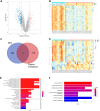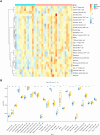Identification of copper metabolism-related markers in Parkinson's disease
- PMID: 39552415
- PMCID: PMC11574951
- DOI: 10.1080/07853890.2024.2425064
Identification of copper metabolism-related markers in Parkinson's disease
Abstract
Objectives: This study aimed to identify key genes related to copper metabolism in Parkinson's disease (PD), providing insight into their roles in disease progression.
Methods: Using bioinformatic analyses, the study identified hub genes related to copper metabolism in PD patients. Differentially expressed genes (DEGs) were identified using the limma package, and copper-metabolism-related genes (CMRGs) were sourced from the Genecard database. Immune cell-related genes were derived through immune infiltration and Weighted Gene Co-expression Network Analysis (WGCNA). Hub genes were pinpointed by integrating DEGs, CMRGs, and immune cell-related genes. Functional analyses included Receiver Operating Characteristic (ROC) analysis, Ingenuity Pathway Analysis (IPA), and networks for miRNA-mRNA-transcription factor (TF), Competitive Endogenous RNA (ceRNA), and hub gene-drug interactions. Validation was performed in cerebrospinal fluid (CSF) samples from PD patients, while in vitro experiments utilized GBE1- overexpressing SH-SY5Y cells to examine cell proliferation, migration, and viability.
Results: Nine hub genes (HPRT1, GLS, SNCA, MDH1, GBE1, DDC, STXBP1, ACHE, and AGTR1) were identified from 753 CMRGs, 416 DEGs, and 951 immune cell-related genes. ROC analysis showed high predictive accuracy for PD, and principal component analysis (PCA) effectively distinguished PD patients from controls. IPA identified 20 significant pathways, and various networks highlighted miRNA, TF, and drug interactions with the hub genes. Hub gene expression was validated in PD CSF samples. GBE1-overexpressing cells displayed enhanced proliferation, migration, and viability.
Conclusions: The study identified nine copper metabolism-related genes as potential therapeutic targets in PD, highlighting their relevance in PD pathology and possible treatment pathways.
Keywords: GBE1; Parkinson’s disease; biomarker; copper metabolism; hub genes.
Conflict of interest statement
No potential conflict of interest was reported by the author(s).
Figures










Similar articles
-
Integrative analysis of potential biomarkers and immune cell infiltration in Parkinson's disease.Brain Res Bull. 2021 Dec;177:53-63. doi: 10.1016/j.brainresbull.2021.09.010. Epub 2021 Sep 16. Brain Res Bull. 2021. PMID: 34536521
-
Identification and Validation of Oxidative Stress-Related Hub Genes in Parkinson's Disease.Mol Neurobiol. 2025 May;62(5):5466-5483. doi: 10.1007/s12035-024-04622-6. Epub 2024 Nov 18. Mol Neurobiol. 2025. PMID: 39556279
-
Identifying the hub gene and immune infiltration of Parkinson's disease using bioinformatical methods.Brain Res. 2022 Jun 15;1785:147879. doi: 10.1016/j.brainres.2022.147879. Epub 2022 Mar 10. Brain Res. 2022. PMID: 35278479
-
SCG5 and MITF may be novel markers of copper metabolism immunorelevance in Alzheimer's disease.Sci Rep. 2024 Jun 13;14(1):13619. doi: 10.1038/s41598-024-64599-z. Sci Rep. 2024. PMID: 38871989 Free PMC article.
-
Biological Function Analysis of MicroRNAs and Proteins in the Cerebrospinal Fluid of Patients with Parkinson's Disease.Int J Mol Sci. 2024 Dec 10;25(24):13260. doi: 10.3390/ijms252413260. Int J Mol Sci. 2024. PMID: 39769025 Free PMC article. Review.
Cited by
-
A bioinformatics approach combined with experimental validation analyzes the efficacy of azithromycin in treating SARS-CoV-2 infection in patients with IPF and COPD These authors contributed equally: Yining Xie, Guangshu Chen, and Weiling Wu.Sci Rep. 2025 Mar 23;15(1):10009. doi: 10.1038/s41598-025-94801-9. Sci Rep. 2025. PMID: 40122903 Free PMC article.
-
Identification of a TIGIT-expressing CD8+ T cell subset as a potential prognostic biomarker in colorectal cancer.Front Immunol. 2025 Jul 29;16:1626367. doi: 10.3389/fimmu.2025.1626367. eCollection 2025. Front Immunol. 2025. PMID: 40799645 Free PMC article.
-
Mechanisms underlying prostate cancer sensitivity to reactive oxygen species: overcoming radiotherapy resistance and recent clinical advances.Cancer Biol Med. 2025 Jul 10;22(7):747-61. doi: 10.20892/j.issn.2095-3941.2024.0584. Cancer Biol Med. 2025. PMID: 40641232 Free PMC article. Review.
-
Clinical updates of B‑cell maturation antigen‑targeted therapy in multiple myeloma (MM) and relapsed/refractory MM (Review).Int J Mol Med. 2025 Feb;55(2):27. doi: 10.3892/ijmm.2024.5468. Epub 2024 Dec 13. Int J Mol Med. 2025. PMID: 39670288 Free PMC article. Review.
References
MeSH terms
Substances
LinkOut - more resources
Full Text Sources
Other Literature Sources
Medical
Research Materials
Miscellaneous
